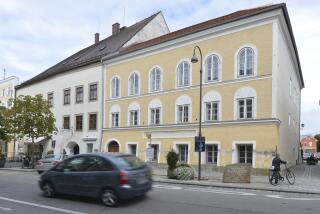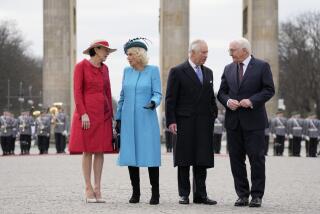Germany’s Royals Getting Belated Respect
- Share via
BERLIN — They’ve been deposed for most of this century, discredited for driving Europe to war, divided by family quarrels and had their legacy damaged by decades of neglect under uncaring Communist stewards.
But the late royals of the House of Hohenzollern that ruled Germany for six centuries and united its fractious fiefdoms in 1871 are now experiencing a resurrection of respect and a more public profile in the freshly minted presentation of history in this newly restored capital.
For the first time in more than 500 years, the ornate tombs of the kaisers are on public display in a refurbished crypt below the Berlin Cathedral, the final resting place of 92 members of the Prussian royal family.
More than 30,000 visitors have toured the cavernous vault in the four weeks since it was opened after a decade-long face lift at the cathedral, says Ruediger Hoth, who directed the reconstruction.
“It was always considered a private family crypt in the time of the kaisers, and commoners were not allowed to come in,” Hoth says. “But today we think it is historically and culturally important to Germans to be in touch with this part of their past.”
Some of the caskets survived remarkably intact despite flooding and occasional dislocation during the era of the Communists, who held religion and the nobility in low regard. Several coffins originally entombed at a church in the Oder River town of Schwedt were left out in the elements for years after the place of worship was converted into a music hall. Others were transferred to the cathedral after East German authorities had Berlin’s Memorial Church razed in 1975. Dozens of the coffins, especially those made from pewter or wood, will take years and small fortunes to be restored, Hoth says.
White marble floors, whitewashed walls and soft lighting give the refurbished crypt a cleaner air than the Hapsburg burial chamber below Vienna’s Church of the Capuchin Friars, the only imperial vault on the Continent larger than that of the Hohenzollerns.
At a ceremonial opening of the vault last month, regional Protestant Church President Helge Klassohn appealed for “a family reunion” to make the cathedral even more significant. He and others active in a foundation overseeing Prussian landmarks want to bring the sarcophagus of Friedrich Wilhelm I, the “Soldier King,” from its resting place in Potsdam to join the remains of his wife and children at the cathedral, including those of his son, Frederick the Great.
But historians and descendants of the Hohenzollerns reject the notion of moving the remains of Friedrich Wilhelm I or other royals whose express wishes were to be buried elsewhere. In addition to the crypt in Potsdam, 20 miles southwest of Berlin, the Charlottenburg Palace mausoleum in the western part of this city houses the remains of Kaiser Wilhelm I and Friedrich Wilhelm III.
“In Berlin, in the 18th and 19th centuries, there were constant disputes between the House of Hohenzollern and city authorities. Berliners didn’t like the royal house, and the feeling was mutual. That’s why Friedrich Wilhelm I didn’t want to be buried here,” says Laurenz Demps, a history professor at Humboldt University in eastern Berlin.
Descendants of the Hohenzollerns, who ruled until Kaiser Wilhelm II abdicated in 1918 after Germany’s World War I defeat, agree that the royal remains should be allowed to rest in peace in their respective places.
“I believe the wishes of the deceased will be respected,” says Prince Wilhelm-Karl von Preussen, a great-grandson of the last kaiser. Von Preussen, a consultant living in Berlin, finds the public gawking at his family’s burial crypt “a little unsettling.” However, he agrees with the designated head of the family, Prince Georg Friedrich von Preussen, that the site belongs to German history and, therefore, to the general public.
While the newly opened vault is proving a popular tourist site, historians emphasize that German interest in the royal family is purely educational.
“This is one of the most important crypts in Europe, and it is good that it is finally open to the public,” Demps says. “But the interest being shown in it is a rapprochement with history for Germans. It doesn’t mean anyone wants the kaisers to come back to power.”
More to Read
Sign up for Essential California
The most important California stories and recommendations in your inbox every morning.
You may occasionally receive promotional content from the Los Angeles Times.














